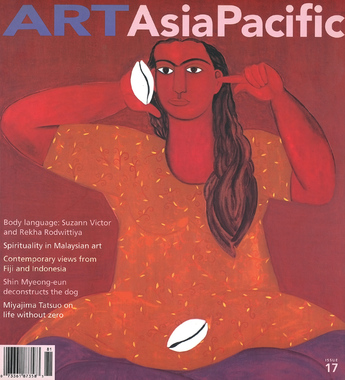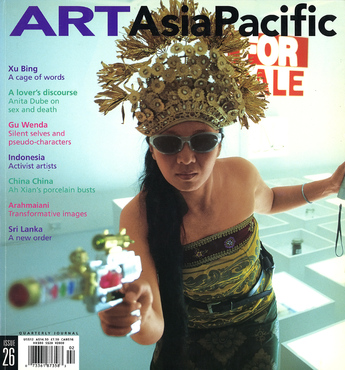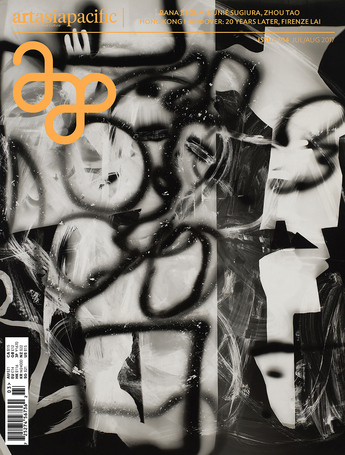
R
E
V N
E
X
T
On October 30, a letter decrying our patriarchal society and its hegemonic power structures dictating every aspect of our lives—including the mechanisms of the art world—was circulated online. Five thousand women—artists, curators, writers and other cultural workers—signed the letter, bringing to the fore a landslide of issues regarding sexual harassment and sexism that has long been bubbling under layers of glass ceilings and nondisclosure agreements.
This world we live in is controlled by the violence of men who allow for the perpetuation of these injustices to occur, and more disturbingly, disallow—or suffocate—positive change for women.
We reached out to the many female artists featured on the cover of ArtAsiaPacific over the years, and asked them if they have ever experienced any form of sexual harassment or sexism in the workplace. They offer their statements and honest thoughts—quoted below—on what we should do to engender change, in an effort to further support the women who have bravely come forward, shattering the first barrier of silence, and to highlight the resilience of female artists. With this article, we hope to shed light on the discomfort and hostility that women artists must navigate in a society shaped by men for men, and to add to the multiple voices that are now speaking out and saying, “no more.”
This is part two of the statements. To read part one, click here.
If you are an artist and would like to submit a statement, please send your words to letters@aapmag.com.
REKHA RODWITTIYA
Featured on the cover of ArtAsiaPacific issue 17.
Sexual harassment has an insidious way of making its presence felt in a country like India, which is steeped in patriarchal overtones, and where little is done to change the ethos that holds male entitlement as the norm of everyday existence. The scant political acknowledgment of gender issues often amounts to little more than paper-pushing of legislature where, finally, the implementation of laws that are meant to protect women remain flawed and ineffectual. Brought up within the influences of female empowerment, my ability as an individual to insist on appropriate behavioral conduct both in my personal world and in my professional space is well known. I am deeply intolerant of any deviant behavior and am a vocal advocate for woman’s rights and minority issues.
However, sexual misconduct is rampant and misogynistic attitudes are on view everywhere in India. Often abetted by apathy and corruption, sexism has deeply stained the fabric of Indian society. The population’s imbalanced gender ratios, for example, indicate how female infanticide—resulting from the common desire for having male progenies, who are traditionally viewed as more valuable than female children—is wide spread. This preference immediately showcases a mindset of inequality in the perception of the female gender. Today, with leaders of nations who can boast of their sexual exploits on television and suggest on public platforms of discourse that it is alright for women to be sexually objectified, I do fear that we have crossed a line where little is viewed as condemnable in relation to sexual vulgarity and women being considered as sexual titillation for men.
I am perplexed by the debates that question the relevance of feminist discourse. Post-feminist rhetoric seems rather bizarre to me when in reality heinous atrocities are committed against women at a staggering rate of every 1.7 minutes in India, often perpetuated from within the areas of a woman or girl’s existence that should in fact offer safety and protection, suggesting therefore that women’s rights are not being addressed with the required effectiveness and desire to enforce immediate action for change.
The art world unfortunately holds these pockets of ignominy where power games and favors are sought through sexual misconduct. The archaic tool most used against women in the art world in India is the rumor factory, which attacks their sexual morality and insinuates that women sleep their way to success. This crass perception is perhaps a result of conservatism at odds with liberal ideals, leading to these outlandish, yet continuously subscribed to, methods of thinking. In the Indian national and regional cultural centers that provide studio-spaces and collective workshop areas for artists, operated by bureaucrats and government officers, the lack of security provided for women have often compromised their safety. Art colleges are also environments where male teachers often indulge in inappropriate behavior with female students. There are also gay teachers who have been known to prey on young male students.
I have often been asked what it is like to be born a woman in India, and whether the overt and subverted displays of male power encountered each day in almost all areas of life wears me down. My answer is always that I view myself as empowered. I see this as a precious inheritance not to be squandered, and therefore accept the challenge to confront and resist, when necessary, the attempts made by external forces that target and infringe upon my territory of equality and freedom. It is by no means easy, and yes, I am sometimes consumed by deep sadness and utter weariness of spirit; but I can never concede defeat and will always desire to stand up and be counted for, for the issues that I believe need my intervention. What change I am able to instigate through these interventions is not the sole criterion of importance. Rather, it is the everyday insistence to exemplify through lived experiences the truth of my identification with the ideological position I stand for that is supremely important for me.
Women authors like Kamala Das, Alice Walker and Maya Angelou brought to my world the stories of the struggles women face, but equally the joy of belief and the celebration of the female spirit. As an artist, it isn’t the theoretical pedagogic that I wish to engage with in my art. My content is culled from the everyday life of the woman—to be perceived, witnessed and acknowledged. I know this to be the space to hold my attention and where the plumb line of my existence must find its equilibrium within the coliseum of collective female histories. I believe the credulous endeavor of finding out how the fundamental ideals of any ideology can hold truth is intertwined with the lives of the ordinary. From the many stories about the courage of ordinary women, both rural and urban, who have championed women’s rights in the subcontinent, I have found my strength.
My works have spoken of the violence, subjugation and oppression that women face. In my works from the 1980s, fractured, cartoon-like drawings populated the picture plane, often with graphic, sexual imagery woven into the kaleidoscopic presentation of tableaus; the works become a sort of frozen theatre of reenactment, holding the viewers’ gaze and forcing a conscience of accountability. In other works, central female figures are also not arrived at by chance. They are consciously placed as an endorsement of female victory—almost as a totemic trophy of the self for the self—to reinforce the embodiment of the female spirit as a vital axis to life itself, and as testament to the indomitable spirit of women as we continue to commit our energies to nurture life, through our capacity to define self-dignity and offer lessons of forgiveness. The female figure, often in isolation, represents the perpetuity of Shakti. Stark and arresting in demeanor, these figures, with their unrelenting gaze, stand like protective guardians of the universe, bearing witness to the passage of time unfolding.
I believe that education from a young age with a focus on examining gender equality would be a step in the right direction to bring about new perceptions that may begin to erase sexism within societies.
ARAHMAIANI
Featured on the cover of ArtAsiaPacific issue 26.
Yes, sexual harassment and sexism has occurred, mostly earlier in my career. I think probably because I wasn’t known then and hadn’t yet built up a reputation as a fearless and critical female artist. When I began to criticize the art market, as far as I can remember, the cases of sexual harassment decreased and almost never happened anymore, but sexism still happened sometimes (well, it still happens from time to time actually, even today). But I never let these incidents weigh me down and I never feel like I’ve lost—I usually stand up and say something.
As you can see, in my work, my critique of patriarchal systems is clear. The incidents of sexual harassment or sexism that I have experienced often irritate me but are also, sometimes, a kind of way for me to address issues of male domination in a fearless and critical way.
I think in order to stop this sexist behavior, first of all we have to make it clear to ourselves that we will not tolerate sexist behavior in whatever form! That we won’t let anybody harass us! Then, after that, we can make these statements clear to public. As an artist, activist and writer, I use all kinds of mediums to deliver this message to the public directly.
Arahmaiani’s artworks are currently on view at the inaugural Museum MACAN exhibition, “Art Turns. World Turns. Exploring the Collection of the Museum of Modern and Contemporary Art in Nusantara” in Jakarta, Indonesia.
MIWA YANAGI
Featured on the cover of ArtAsiaPacific issue 35.
In Japan, less than one percent of Parliament members are female.
Established organizations, both public and private, are homo-social and patriarchal. Among them, the world of contemporary art is most gender-free, relatively speaking.
Gender discrimination exists both in the worlds of self-employment and institutions, but the types of discrimination differ; self-employed women tend to be ignored, while women in institutions tend to be brainwashed.
I, for example, work in the fields of contemporary art and performing arts. The latter is a collective activity, comprised of various institutions such as troupes and theaters, and I often feel that things are patriarchal. In particular, being a female producer or director is not easy. Many men in Japan continue to think that they have to protect women, and they cannot think or act differently. I encounter this problem all the time in theater productions.
People say that things are hard for women in Japan, but the times are tough for men as well, and they, too, should free themselves from sexist mentalities.
I hope that by getting involved in my projects or looking at my works, many men will change their minds.
Translation by Saeko Shibayama.
MITHU SEN
Featured on the cover of ArtAsiaPacific issue 95.
People’s perceptions of me contains some measure of sexuality, for several reasons. I am a woman artist who creates a large body of work dealing with sexuality in myriad forms, so some of these perceptions are simply a response to my artistic practice—but a large majority is the viewer’s own performance of sexuality which is both knowingly and unknowingly projected on me. It is the latter act, in its many manifestations, that is part of my story too. I have been harassed, pushed back and stared down.
Since my solo show “I Hate Pink” in Mumbai, in 2003, I have produced images with explicit sexual content. “I Hate Pink” formulated my feelings on gender politics, through the medium of drawing. Since then, the multi-gendered “male gaze” has had its eye on me; it watches, follows and intrudes. Patriarchal reactions from both men and women, deeming my works as provocative and attention-seeking, were a blow. I was hurt by the myopic engagement extended to me, a woman. But I embraced the criticism and resisted and persisted. Again I pushed the boundary in 2006 with the exhibitions “Drawing Room,” and then with “Black Candy (iforgotmypenisathome)” in 2010. I wanted to subvert the male gaze. I wanted to stare back—sometimes with love and tolerance, and other times with humor and teasing.
Over the years, many friends, loved ones and acquaintances have expressed their displeasure with my identity as a sexual being. On the flipside, many have taken the liberty of crossing into uninvited territory by barging into my personal space, thinking: “Surely a bold woman can handle trespassing; maybe she wants to like it, or, better still, she likes it.” Harassment continues, and so do I. I simply continue to do what I deem important and necessary in the moment. Being sexual means staying raw and connected as a state of being. I stare at the gaze, which pierces my skin and soul, my body processing the invasion, the experiences running through my veins, whether sexual or asexual.
KUNIÉ SUGIURA
Featured on the cover of ArtAsiaPacific issue 104.
Whenever I think of the reports about sexual harassment in media and cultural news in the last few years, I am so shocked, and feel empathy for the people who have suffered and are traumatized by what they have gone through.
These hideous crimes have permeated through many levels of different industries, which is astounding. For some of these people, they have spent a long time with their anger pent up, unable to resolve the humiliation they experienced and seek justice. But now, finally, the veil has been lifted, and people are talking about the issue on social media; support systems like #MeToo have even appeared.
Articles such as this one, which collect information and confront male assaults, are healthy reactions. We must provide this information for future generations, so they know what to do and can protect themselves. These crimes are connected with deep, unclarified areas like desire, love and abuse of privileges. Even a short meeting can trigger a lifetime’s worth of suffering and disaster for victims.
I have experienced an abundance of sexism since the 1960s, including incidents of sarcastic remarks, jokes and more pointed attacks. There were so many more men than women in the art world that we became accustomed to being squashed. That provided the impetus for the feminist movement in that decade. Jobs, pay equality and educations have since improved, and I cannot even imagine going back to the ’60s. It started out as a very mundane initiative, to solve practical problems. But as we see with racial struggles in America now, things can roll back at anytime.
Sexism is prejudice, just like racism. There are people who do not want to see the real situation. Equal education is a very urgent matter, but takes enormous patience and communication between individuals. We need a new way to educate the next generation to guarantee equality.
To read more of ArtAsiaPacific’s articles, including those that cover the art practices of the women artists who have shared their words here, visit our Digital Library.







